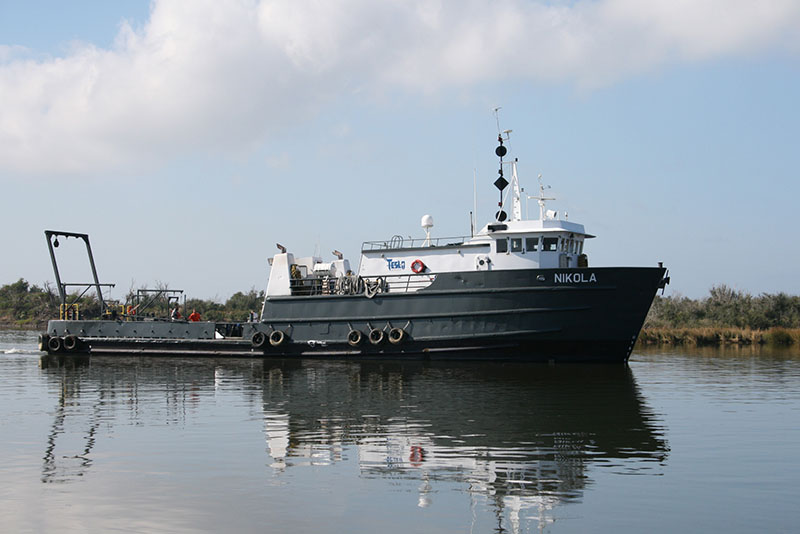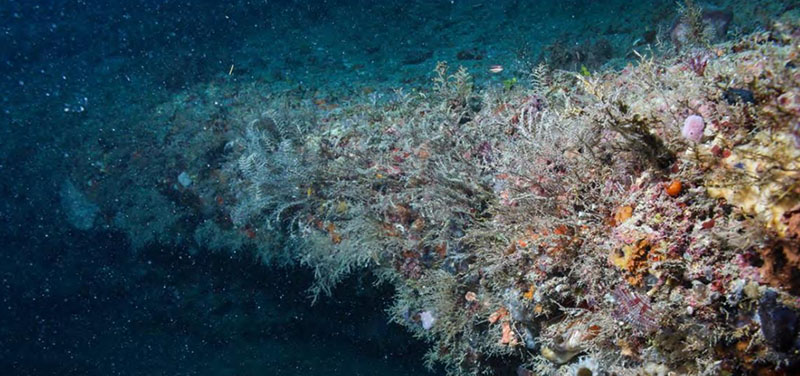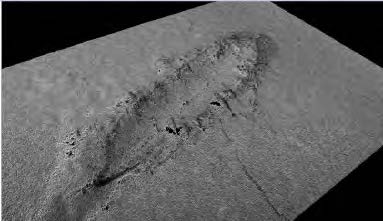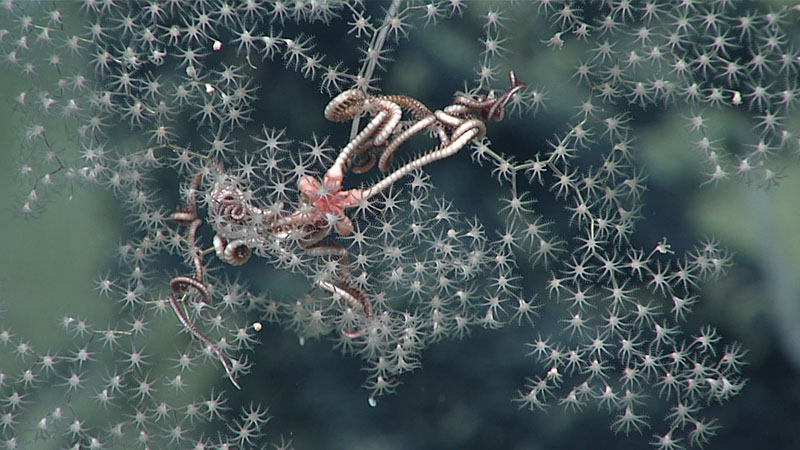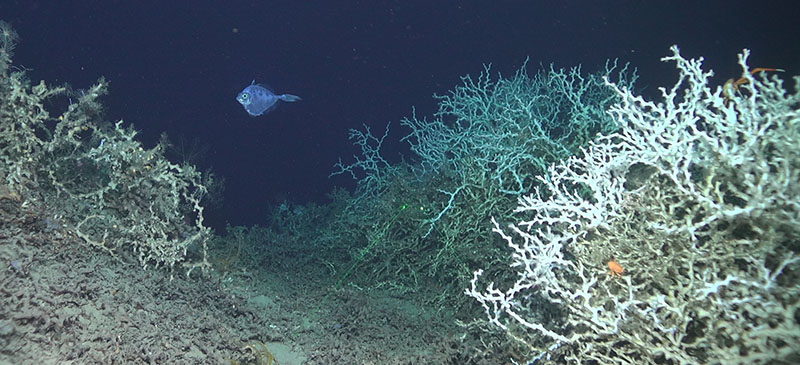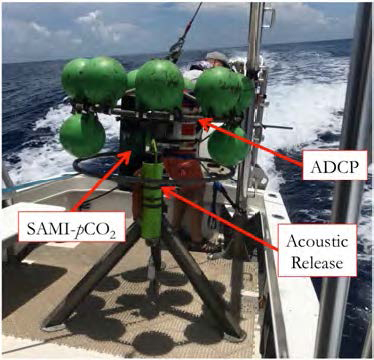NOAA Office of Ocean Exploration and Research Fiscal Year 2018 Federal Funding Opportunity Grants Awarded
March 28, 2019
As part of the Fiscal Year 2018 Federal Funding Opportunity, the NOAA Office of Ocean Exploration and Research selected 10 projects to receive financial support. The supported projects are described below. For information on projects funded via this competitive opportunity from Fiscal Year 2014 through present, visit this page.
Paleolandscapes and the ca. 8,000 BP Shoreline, Gulf of Mexico, Outer Continental Shelf
Principal Investigator: Amanda Evans, Coastal Environments, Inc.
The project includes geophysical survey and sediment coring, centered in, but not restricted to, the High Island federal lease area in the Gulf of Mexico. The resulting data will be used to create baseline characterizations of, and delineate archaeological horizons within, the ancient landscape (paleolandscape) associated with the shoreline stand 8,000 calibrated years before the present (ca. 8,000 BP).
Development of Innovative Techniques for Exploring Novel Submarine Springs on the Gulf of Mexico Outer Continental Shelf
Principal Investigator: Emily R. Hall, Mote Marine Laboratory
Offshore submerged sinkholes and spring features, or “blue holes,” host several commercially important fish and can be considered ecological hotspots, yet because they often reach depths greater than 130 meters (426 feet) and are thus beyond normal scuba limits, they have received limited scientific study. The principal objectives of this work are to 1) repurpose and repackage existing high-tech marine biogeochemical instrumentation to create a benthic lander to access and explore offshore submerged sinkhole and spring features; 2) deploy the platform in conjunction with macrofauna surveys, genomics, and geochemical sampling of two known blue holes at depths greater than 100 meters; and 3) disseminate data and images to captivate the minds of the public and garner future interest from scientists.
Microbial Stowaways: Exploring Shipwreck Microbiomes in the Deep Gulf of Mexico
Principal Investigator: Leila. J. Hamdan, University of Southern Mississippi
More than 2,000 shipwrecks spanning 500 years of history have been lost in the Gulf of Mexico. Over time, these shipwrecks become artificial reefs and islands of diversity. The effect these historic shipwrecks have on microorganisms in a particular environment and how wrecks shape microbial biogeography has never been explored. This project will apply a cross-disciplinary approach to explore how shipwrecks and seafloor hydrodynamics in the Gulf of Mexico shape deep-sea microbiomes and place the remote seafloor in context with contemporary change.
From Aggregations to Individuals: Exploring Migrating Deep-sea Scattering Layers Through Multiscale-multimode Technologies in the Gulf of Mexico
Principal Investigator: Kevin M. Boswell, Florida International University
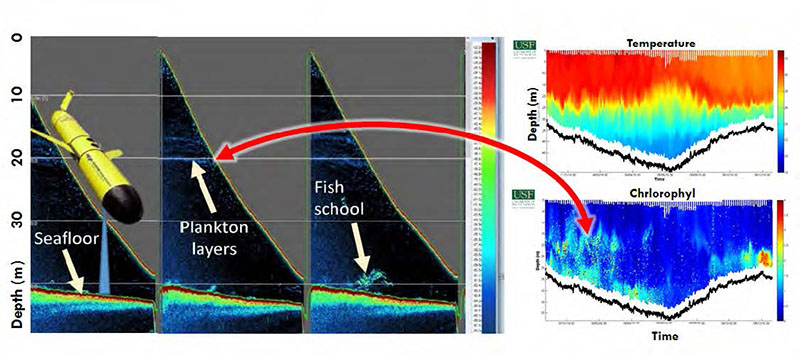
Glider-based echosounder water column biomass and water column variables simultaneously collected in coastal Florida waters. (a) Three consecutive glider descent echograms illustrating high-resolution plankton layers and fish aggregations in the water column. (b) Time-series plots of temperature and fluorescence plotted over a two-week deployment. Comparing results of the acoustic biomass with other sensors increases understanding of fish and zooplankton dynamics and demonstrates the utility of combined sensor packages. Images courtesy of Kevin Boswell.
This study will involve the exploration of Gulf of Mexico communities in the mesopelagic zone (between 200 and 1,000 meters; 656 and 3,280 feet) using emerging acoustic and optical sensors on autonomous platforms to discover the dynamics of these animal communities within the complex oceanography of the Gulf. The exploration will address constraints in biomass sampling resolution in the water column by providing multi-scale observations of migrating Scattering Layers (SLs) in the Gulf of Mexico, obtaining simultaneous measurements of the dynamics of individual through aggregations using a suite of sensors on autonomous platforms.
Advancing eDNA as a Tool for Exploration in Deepwater Environments
Principal Investigator: Jill McDermott, Lehigh University
Organisms continuously shed cells and leak DNA into their surrounding environment and environmental (e)DNA is emerging as a non-invasive methodology for capturing and sequencing this DNA to rapidly explore and characterize the biodiversity of an area. This study will develop a framework to establish eDNA metabarcoding as a standard ocean exploration tool, to enable rapid, economic, and comprehensive diversity assessments of deepwater fauna. The work will involve quantifying and predicting the temporal persistence of eDNA in a laboratory setting and then testing the established eDNA metabarcoding framework in Flower Garden Banks National Marine Sanctuary in the Gulf of Mexico. The project will also include exploration of the biodiversity in unknown or poorly known areas in the Gulf of Mexico and the southeastern U.S. Exclusive Economic Zone (U.S. EEZ) and improvement of the DNA barcode databases for corals and fishes from the Gulf of Mexico and the southeastern U.S. EEZ.
Combining Habitat Suitability and Physical Oceanographic Models for Targeted Discovery of New Benthic Communities on the West Florida Slope
Principal Investigator: Sandra Brooke
Unlike the northern Gulf of Mexico, there has been little research effort in the eastern Gulf of Mexico; however, in recent years, several cruises conducted mapping and surveying of the west Florida slope and revealed extensive deep coral habitats, including large Lophelia reefs. Pressure to protect deep-sea coral habitats has created a need to understand their distribution. For this project, scientists will use available habitat suitability modeling as well as a high-resolution oceanographic model to select target study sites for coral habitat (including Lophelia) on the deep (greater than 1,000 meters) habitats and associated communities of the west Florida slope and will validate the oceanographic model in a novel approach using meiofaunal communities.
Exploration and Characterization of Fine‐scale Physical‐biogeochemical Environment Over Deep Coral Reefs on the West Florida Slope Using Integrated ROV‐lander‐sensor Systems
Principal Investigator: Zhaohui Aleck Wang
We have limited understanding of how the variability of carbonate chemistry and other environmental conditions surrounding deep-sea corals are critical for their long-term adaptation and survival. This project involves a comprehensive multidisciplinary study to explore and characterize two deep coral habitats with contrasting benthic communities on the west Florida slope of the Gulf of Mexico, including the testing of newly developed sensors deployed on an ROV to map and fully resolve the carbonate system at the sites. Additionally, two newly developed landers equipped with state-of-the-art sensors will be deployed at the two sites over 6-8 months to capture fine-scale temporal variability (hours) of carbonate chemistry and other key parameters. This study will be the first to document such fine-scale variability around deep reef systems in the eastern Gulf of Mexico.
Optical Sensing of Ocean Gases Using Photothermal Interferometry
Principal Investigator: Anna Michel
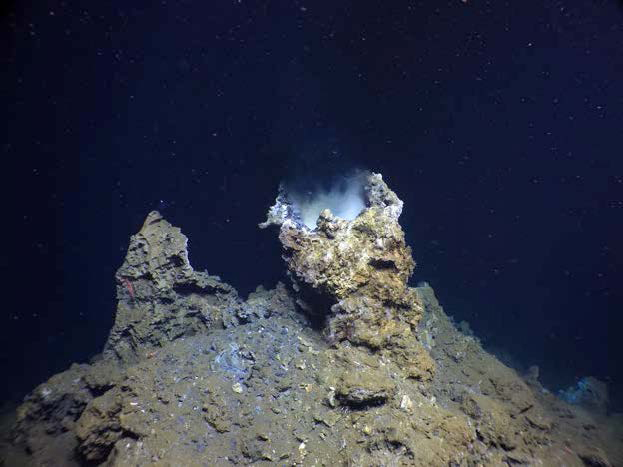
Exploration of hydrothermal vents, such as Diane’s Vent at the Pescadero Vent Field, will be greatly enhanced by the development of new, highly sensitive, compact dissolved gas sensors. Image courtesy of Ocean Exploration Trust, Woods Hole Oceanographic Institution, Dalio Foundation, Alucia Productions, Adam Soule, and the MISO Facility.
The work will include the design, development, and field testing of a miniature ultrasensitive dissolved gas sensor for measuring carbon dioxide and methane in situ, using photothermal interferometry (PTI), an optical absorption gas detection technique. This sensor will be developed for deepwater applications and will allow us to measure these important gases without the need for physical samples. It will be small, low-cost, and easy-to-deploy from a range of platforms.
Exploration of the Deep Ocean with Teams of Long-endurance Ocean Robots
Principal Investigator: Michael V. Jakuba
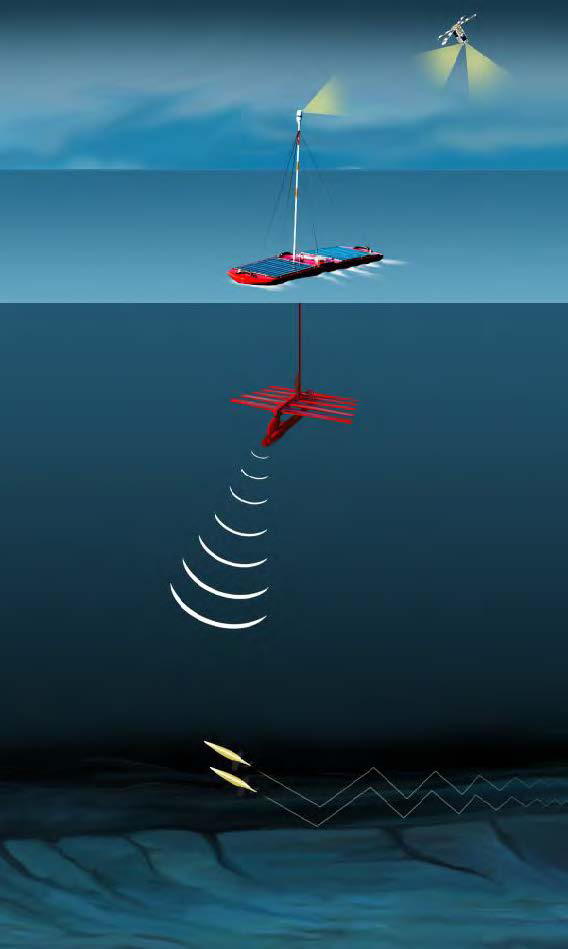
The multi-robot long-range exploration system envisioned in this proposal. A Waveglider automated surface vehicle (ASV) provides navigational aiding and mission updates to two submerged Seaglider autonomous underwater gliders (AUGs) performing high-resolution water column mapping. Image courtesy of Michael V. Jakuba.
This project will include an autonomous exploration to map hydrothermal activity along the 200-kilometer extent of the Gorda Ridge off the U.S. West Coast. Scientists will generate transects of deep physical oceanography and hydrothermal plume activity along the ridge axis sufficient to identify seafloor vents to within one kilometer; existing maps of venting along the Gorda Ridge will provide ground truthing against which to validate the results. At the conclusion of the project, two Deepglider-compatible one-way travel time inverted ultrashort baseline positioning (OWTT-iUSBL) units will exist to enable future exploration and the OWTT-iUSBL system design and algorithms will also transfer to future multi-vehicle teams.
Advances in Deep-sea Sampling with Soft Robotics
Principal Investigator: Stephen Licht
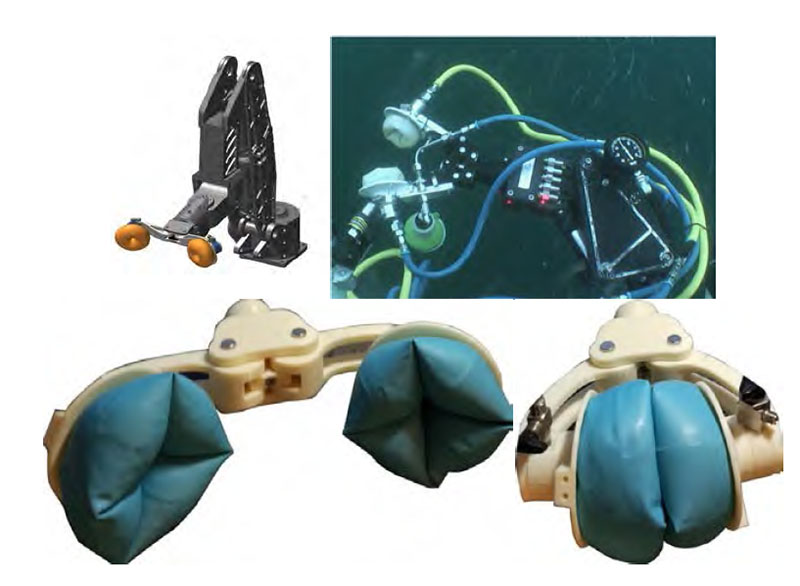
Robotic gripper prototypes. Top left: Initial concept design shown mounted to the wrist joint of a Kraft Predator underwater seven degrees of freedom arm. Top right: Image of second generation prototype on a SeaEye remotely operated vehicle HydroLek arm. Bottom: Third generation prototype showing range of motion and potential membrane configuration. Images courtesy of Stephen Licht.
Soft robots and compliant manipulators have been shown to dramatically simplify the problem of grasping complex objects without exerting undue force on the object or its surroundings. As a result, robots are increasingly being used for gentle and precise grasping tasks; however, many of the compliant mechanisms that have been developed for use in air are pressure intolerant, unsuited for use in water, or unable to withstand repeated deployment and recovery at sea. This project will advance soft robotic manipulator systems technology suitable for selective sample recovery from sensitive cultural and biological sites, a key area of ocean exploration science. This project will demonstrate (a) a novel hybrid soft robotic gripper and (b) a next-generation drive mechanism that will enable the precise control of seawater hydraulics for soft manipulation and that are inherently safe, reliable, and robust for deepwater deployment.
